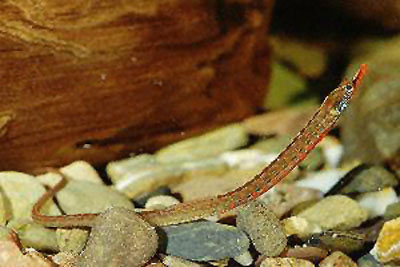| Syngnathidae (Pipefishes and seahorses), subfamily: Syngnathinae |
| 13.64 cm SL (male/unsexed) |
|
demersal; freshwater; brackish; pH range: 7 - 7.5; dH range: 10 - 18 |
| Africa: western coast of Africa from the Gambia river drainage (Gambia) to the Cuanza river (Angola) (Ref. 4127, 81680). |
|
Dorsal spines (total): 0-0; Dorsal soft rays (total): 22-29; Anal spines: 0-0; Anal soft rays: 2-3. Diagnosis: 11-15 (median 13) pectoral fin rays; head length 8.4-10.8 (mean 9.4) times in SL (Ref. 57226, 81680). Snout tubular, relatively short (Ref. 57226), ratio head length/snouth length 2.0-2.8 (mean 2.5)(Ref. 57226, 81680).
Description: total number of rings 44-50 (Ref. 81680), 12-13 trunk rings and 31-37 tail rings (Ref. 57226, 81680). 5.0-6.5 subdorsal rings; dorsal fin origin from middle of last trunk ring to origin of second tail ring, usually at anterior margin of first tail ring; snout length positively allometric (Ref. 81680). Male brood pouch extending onto 12-17 rings of the tail; caudal fin with 9 rays (Ref. 57226, 81680). Dorsal-fin origin above anal fin, either on last ring of trunk or on first ring of tail (Ref. 57226).
Coloration: colour pattern with a complex pattern of bars and blotches, with, as far as can be judged from preserved specimens, considerable intraspecific variation, but it is unclear which variation is due to sex and/or sexual maturity (Ref. 81680). Belly brown to red-brown, with pale greenish to grey blotches; ventral part of head whitish or light brown; tail and lateral part of body with a pattern of alternating dark and light brown or whitish bars and blotches; this pattern continues onto dorsum in some specimens; in others, dorsum uniformly dark brown; snout sometimes with alternating dark brown/light brown to whitish bar pattern; opercle with fine white-green iridescent lines; dark and light bars radiate from eye; distal part of dorsal fin hyaline and proximal third or more of each dorsal fin ray shaded with brown; proximal third of pectoral fin blotched or shaded with brown, otherwise hyaline; caudal fin with irregular brown blotches, margin usually pale (Ref. 81680). Back and lower sides with irregular diffuse bars occurring every 4 or 5 rings; rectangular brown spot on every ring and on ventral surface of body; light brown irregular spots on sides of trunk and tail; caudal fin marked with irregular spots (Ref. 57226). |
| Adults occur in coastal rivers and streams (Ref. 4127, 81680), and swamps (Ref. 57226, 81680). Seems confined to fresh water habitats and breeds in fresh water (Ref. 81680). Ovoviviparous (Ref. 205). Feeds (mainly) on copepods (Ref. 81680). Male carries the eggs in a brood pouch which is found under the tail (Ref. 205). Dawson (1981) reported 17-36 postlarvae in the brood pouch of males of 75.5-82.5 mm SL; a larger male (MRAC 143259: 136.4 mm SL) caught in December 1964, in a swampy area about 200 m from the coast of Bioko Island (formerly Fernando Poo), has its brood pouch filled with several hundred postlarvae (Ref. 81680). |
|
Least Concern (LC); Date assessed: 06 June 2016 Ref. (130435)
|
| harmless |
Source and more info: www.fishbase.org. For personal, classroom, and other internal use only. Not for publication.

